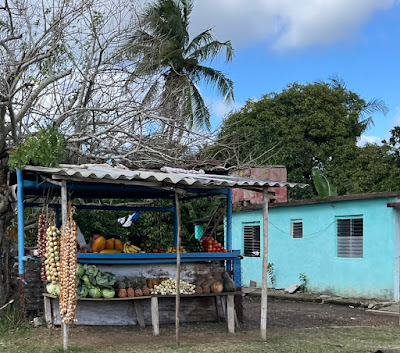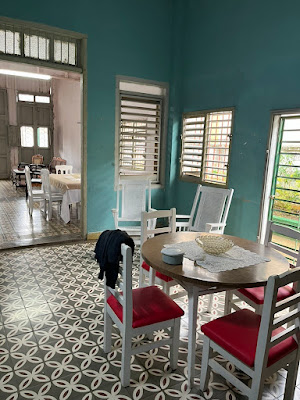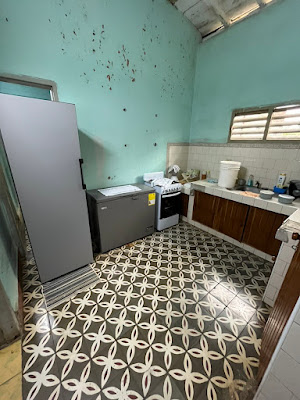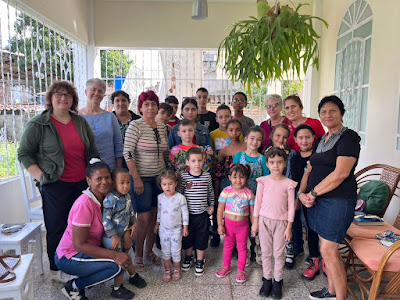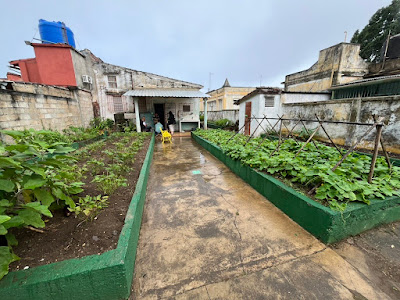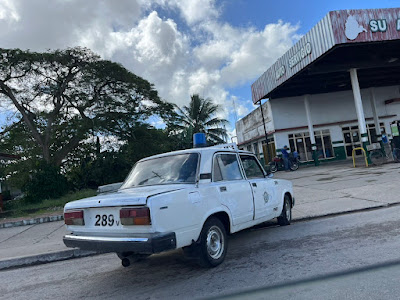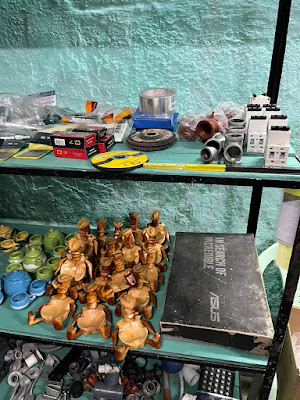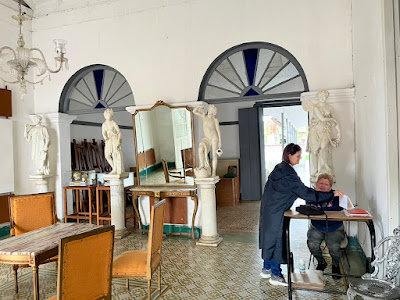On our second day in Placetas we got to walk around town with our hosts a bit. It had been raining on and off for about 48 hours, but there was finally a break in rain and we walked a few blocks over to the town center. Our hostess laughingly called it their "mall".
This dog was posing quite nicely for us. He looked pretty well cared for.
The dog below also clearly got a lot of love from his shopkeeper owner.
Although my phone wasn't good for much other than taking pictures throughout the trip, the GPS and mapping did work. The towns that we passed through on our drive to Placetas were are pretty compact and were laid out on a grid. Our host lived just a few blocks from the city square and from his church, pretty convenient to walk. You could probably cross the whole town in less than 15 mins on foot. Wikipedia says the town population is 65,000.
Horse buggies were quite common in town and outside of town. These carts were designed more to serve as taxis with seats for passengers. The horses all had blinders on which I'm sure kept them from spooking quite as much when other vehicles passed them.
There were potholes in the potholes. Although the roads probably had less wear with less traffic and heavy trucks compared to our roads, they were pretty rough. I didn't even see any sign of patching, so these were what was created back in the day and what was left today.
The street where our hosts lived was the site for market stalls on Sundays. Unfortunately we missed it by a day. There were some stall frames that appeared to just stay in place throughout the week and a pile of metal framework that must go up and down on market day. I don't know what kind of goods were in this market, but I'm guessing a lot of homegrown vegetables among other things.
The front porches and sidewalks appeared to be elevated. Each home as a concrete ramp from the patio to the street. I asked our host if there was flooding sometimes since the gutters seemed to be so deep. He said, yes, in the spring.
This is Placetas City Hall. A pretty building with no traffic going in and out. I'd be very curious to know what kind of business happens in local government. The only evidence I saw of authority was an old police car and two soldiers along the side of a rural road in military dress who were apparently waiting for a ride to go back to their base. The police car was quite old too, but I don't imagine they have many road chases happening here.
This is the park in the city center. Easily the prettiest part of the town that I saw, but no one was around because of the rain.
The church in the distance is the local Catholic church. My friend had seen it on a previous visit and said it was quite beautiful inside.
I was fascinated by the various goods that were on sale in different shops. I took this picture to get an idea of some of the prices (you can only see them if you zoom in a lot). They had a lot of packaged foods and I think they were relatively pricey. The official exchange rate is 300 pesos to $1, one package of cookies cost 350 pesos. Given the salaries that the pastors made which were good compared to many people, I can't imagine too many folks could afford a bag of oreo-like cookies very often.
This was a bookstore and coffeeshop. Pretty nicely kept.
Fanta was 100 pesos, a ham and cheese sandwich 200 pesos. I don't know if this was actual name-brand Fanta or not. I didn't see any name brand US products at all - no Coke, Pepsi, McDonalds, Starbucks, etc.
Cafe Bombon is a Spanish and Cuban drink made with sweetened condensed milk and espresso. Our host made this our first day for his wife and seemed disappointed that Darcy and I didn't want any (neither of us like coffee).
This was one of the only shops I saw that I would call a grocery store. There were large bags of rice and cooking oil and a few canned goods on the shelves. I'm not sure what was in the coolers, but it was a far cry from Costco.
Many of the shops we walked through were actually indoors booths, not singular shops. The items they had on sale were pretty random even within one vendor's booth. It would be challenging to know where to shop for a particular item if you weren't familiar with all the different booths in each building.
Rice cookers were definitely a thing.
This was one of the few booths with a clear theme: hardware/home repair
The shops above and below were "govn't stores" according to our hosts. Note they are large, but mostly empty. They did not share space with any other vendor.
I just took this picture to note the price of these window blinds that everyone used: the larger ones were 5800 pesos about $20.
At one point I asked about what industries were in the areas. I was surprised to learn that there is a significant aluminum industry in the town. This was evident with all the plates, bowls, serving ware, and I expect the window blinds were aluminum too. This has apparently replaced the sugar cane industry that was booming before the revolution.
The spoons look they are going to be very heavy (like stainless steel), but they are quite light.
Another local industry is plastic molding. We saw a lot of cheap plastic items from children's plastic play figures to these 'Wellies' that so many people were wearing.
Random life sized horse statue in a window.
Our hosts offered no explanation when we pointed it out, they just laughed.
I was fascinated that this shop keeper was keeping track of her sales by hand in a ledger.
Tacky Cuban spoon holders, tea sets, circuit breakers and tape measures all sitting side by side.
We didn't see a lot of blatant Christmas decor, but this guy was notable.
So much to see you can't even figure out what to look at. Our host stopped in one store that was selling some solar powered product because he was looking for the item and thought they might have a good deal, but he walked away without it, so it must not have been a good deal. He said you also check on things because you never know when you'll find something you need.
This was probably the prettiest part of the town next to the town square park. It was a green space running down the center of a street in the market area. Side walk was relatively in tact and the trees were big with lots of shade. Probably very popular during the summer.
Our host shared a story about this shop and owner. It was clearly high brow. The tile out front was new and so was the front. It had a very modern garage door to close up the shop and it was all just one vendor with fancy home decor items. From my understanding, he got some kind of entrepreneurial loan and invested it well and has slowly grown his business and gone upscale.
This cafe was totally unexpected! I saw 9 3/4 on the door frame and thought...Harry Potter?! Yep.
I stood in the doorway (everything is open air) and took a picture, then I wandered out and up the street. the fellow in the green jacket (only person there) followed us and started bugging our host. I'm quite certain he was asking for us to buy something or pay him money for the picture. I felt bad our host had to put him off.
This was the city museum. More of a concept than a place to visit at the moment. The lady was excited to tell us a little bit of the archeological history and to explain that they had a grant and were updating the displays to include four eras (indigenous, colonial, pre and post revolution).
For our last night in Placetas, our English-speaking host disappeared at dinner time (probably worn out from so much translation work), leaving Darcy and I to join his wife and the lady who had been helping with meals with no one to translate. I had the awkward moment to decide if we sit in awkward silence or try to find something to share with each other that my very basic Spanish vocabulary could accommodate. I settled on 'family'. The kitchen lady shared pics of her grandkids, I shared pics of my kids and pets. We got to talking a bit about travel. Our hostess was speaking very slowly in toddler-level Spanish and I was able to pick up about 1/3 of what she was saying. She was thrilled to be understood at all. After about 30 mins, my brain was done trying to make sense of what it was hearing and I was glad the meal was over. It was a super nice evening and I'm glad we were able to connect even with the language barrier.













